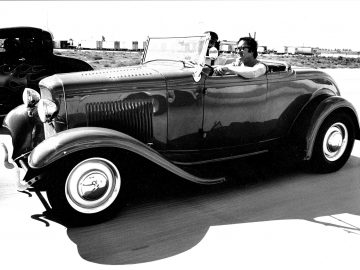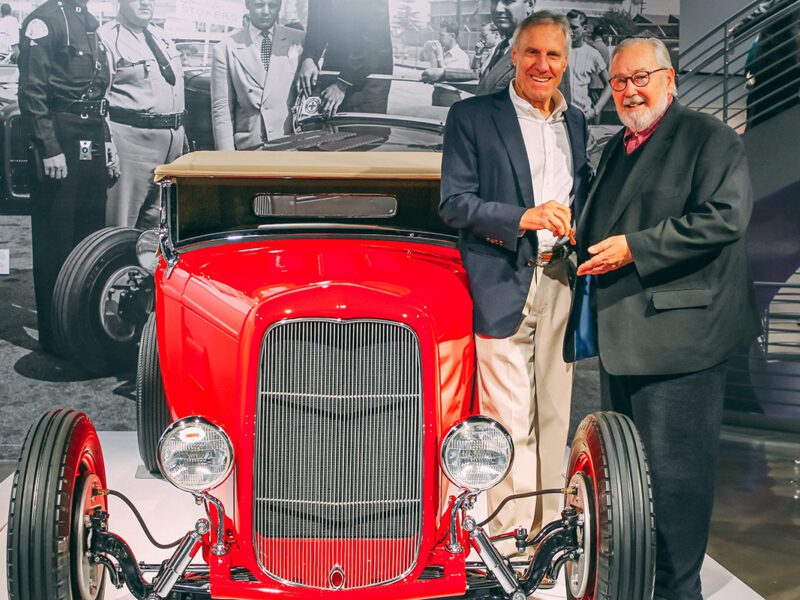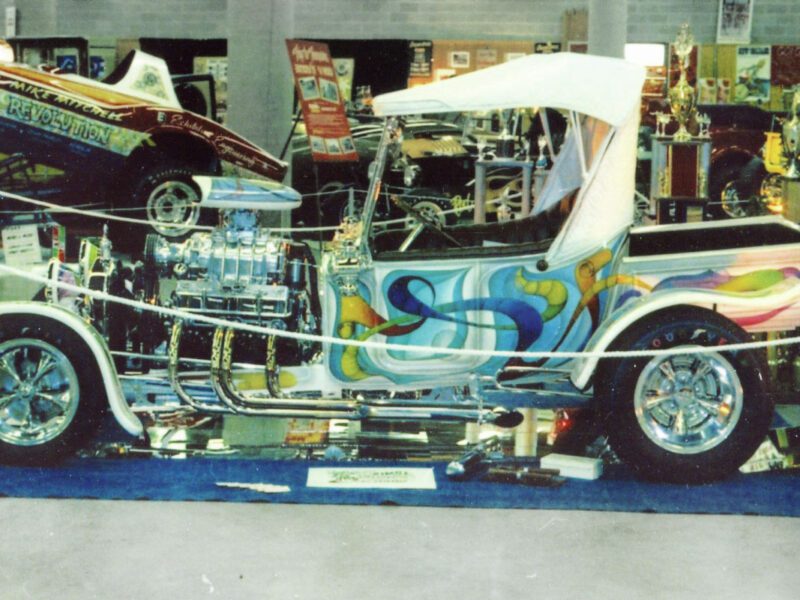Gray Baskerville, “Yer Ole Dad” of Hot Rod Journalists
Publishers publish. Editors edit. But it’s writers who distil the essence of the subjects they write about. And no one wrote about hot rods quite like the late Gray Baskerville, who passed away in 2002 after more than three decades as a journalist and photographer for HOT ROD and Rod & Custom magazines.

Gray Baskerville, the people’s Hot Rodder (image source: Royalshifter Feb 22, 2009)
Charles Gray Baskerville was a child of the City of Angeles, born August 16, 1935, in the sleepy beach town of Hermosa Beach. Perhaps it was this sun-bleached start to life that led to Gray’s signature “look” — t-shirt, shorts, Barry Goldwater black rim glasses, and flip-flop sandals, regardless of the weather.
Being born in the Thirties meant his first driving years coincided with the dawn of the California post-WWII hot rod culture, fueled in large part by the influence of a fledgling publication called Hot Rod. And he joined in the fun, becoming a noted drag racer in the late 1950s and early ’60s with a B/Altered Model T roadster pickup.
But Baskerville also had a passion to put words-to-page, as well as pedal-to-floor. He was a smart kid and attended the University of California, Santa Barbara and earned a degree in History.
That Gray, affectionately known as “yer ol’ dad,” would become a talented automotive writer is no surprise. His grandfather started Motorcyclist magazine in 1919, and following Gray’s stint at UCSB, he began working for the popular 2-wheel publication. By 1968, his journalistic talents landed him in the Petersen Publishing (publisher of Hot Rod) book division, at which point serendipity took over.
Tom Medley, of Stroker McGurk fame, had just assumed the reins of Rod & Custom with the intent to focus on the street. “One day, I pulled into Pete’s [Petersen] parking lot,” Medley would recall, “and there was this red full-fendered ’32 roadster, a traditional hot rod. I asked around to see who owned it. Some guy in the book division, I was told.” Medley quickly recruited the flip-flop attired, buzz-cut Baskerville to join the R&C staff. He moved to Hot Rod when Rod & Custom was killed off in 1974.

This is Gary Baskerville’s ’32 Roadster, famed for having been driven nearly every day by the legendary Rod & Custom and HOT ROD staffer. (image source: HOT ROD network)
Throughout his career, Gray was defined by that ’32 roadster as much as he was by flip flops and unconventional sentence structure. The deuce was originally owned by Gray’s dear friend, Paul Horning, who put it together in the mid-1950s as a race car. When Horning died in a motorcycle accident in 1966, the estate sold it to Baskerville for the princely sum of $500. Eventually, the race motor gave way to a 283 small-block coupled to a cast-iron Powerglide and ’52 Lincoln differential, and it settled into driver mode. Daily driver mode, as in every day. It was his sole vehicle for decades and logged than 250,000 miles on the odometer.
As a writer at R&C and Hot Rod, Baskerville was in his element. His love for hot rods was absolute, and he would impress every car builder with his knowledge and reporting accuracy. And his photographic chops developed, too. But it was his wordsmithing that set him apart. He could coin words and turn phrases like no other. His style was homespun and honest, just one hot rodder talking to another.
Gray once described fans of woodie station wagons as “fir heads,” and brisk hot-rod accelerations this way: “At throttle’s touch is instant launch, guaranteed to snap tum-tums around spinal columns while causing a very real brain-draining case of the vertigos.” You can almost feel the g-forces.
While his readers loved it, his style drove copy editors nuts, trying to fit correct grammar and style to his supercharged stream of colloquial prose. “I had arguments with copyeditors who complained about Gray’s style,” remembers Jeff Smith, a former editor of Hot Rod who worked with Gray. “I told them that he was a ‘Hot Rod’ institution and that it would remain as he wrote it!”
 Each summer, you could set your clock to Baskerville being the first photographer on the Bonneville salt each morning during SCTA Speed Week. It was his happy place and he gleefully witnessed decades of speed trials behind the lens. When nostalgia drag racing took off in the 1980s, Gray never missed a race. He did a lot for Goodguys in that regard, giving our brand of vintage drag racing worldwide page views in Hot Rod as well as Rod & Custom when it was brought back. We also grew close to Gray during that time learning his eccentricities. When a drag machine or salt car would lite his wick, he would howl/chuckle/laugh and wiggle his hands. It was the Baskerville seal of approval of your car being entertaining and bad ass. It was like a rite of passage.
Each summer, you could set your clock to Baskerville being the first photographer on the Bonneville salt each morning during SCTA Speed Week. It was his happy place and he gleefully witnessed decades of speed trials behind the lens. When nostalgia drag racing took off in the 1980s, Gray never missed a race. He did a lot for Goodguys in that regard, giving our brand of vintage drag racing worldwide page views in Hot Rod as well as Rod & Custom when it was brought back. We also grew close to Gray during that time learning his eccentricities. When a drag machine or salt car would lite his wick, he would howl/chuckle/laugh and wiggle his hands. It was the Baskerville seal of approval of your car being entertaining and bad ass. It was like a rite of passage.
Ol’ Dad also had a wonderful sense of humor and was a prankster. Let hot rod historian and book publisher David Fetherston explain:
“He was one of those lovely eccentrics who made the California hot rod scene so interesting to me. Sometimes at the Oakland Roadster Show, Gray Baskerville would swap his press pass with mine. He’d walk around shooting pictures for couple hours, meet up with me again, and swap it back. He loved confusing people just for the fun of it! It was typical of the crazy, unconventional character he was!”
Few people knew Gray as well as Pete & Jake’s Hot Rod Parts founding partner and So-Cal Speedshop President, Pete Chapouris. “Gray Baskerville was my friend, a real friend,” he said. “One of those friends you count on one hand. There’s not a hot rod business alive today that does not owe their existence, in part, to Baskerville. He helped perpetuate the renaissance of hot rodding in the late 60’s and on through the 70’s and ‘80s even into the ‘90s.”
In the year 2000, Gray was convinced to go through the ’32 roadster — a quarter million miles on the clock will do that. The job was handled by Art and Mike Chrisman, with strict instructions to just freshen it up. Leave the drivetrain and look of the car as is, same motor, same tranny, same everything. Chrisman pulled off the body and detailed the chassis, power coated it and had the axle chromed.
But while his beloved deuce was getting new life, Gray’s life was threatened by a diagnosis of cancer. As his condition worsened, progress on the roadster continued and by the time it was completed, Gray Baskerville was bedridden. So, Art picked up Gray in Pasadena, hauled him to Santa Ana, and drove him back home in the ’32. Gray’s last ride.
Tim Bernsau’s obituary of Gray Baskerville in Hot Rod put it best: “He was an original and the most enthusiastic hot rodder in the world. He was a sage, a nut, a beatnik, a preacher, radical, reactionary, the eternal teenager, and yer ol’ dad.”




